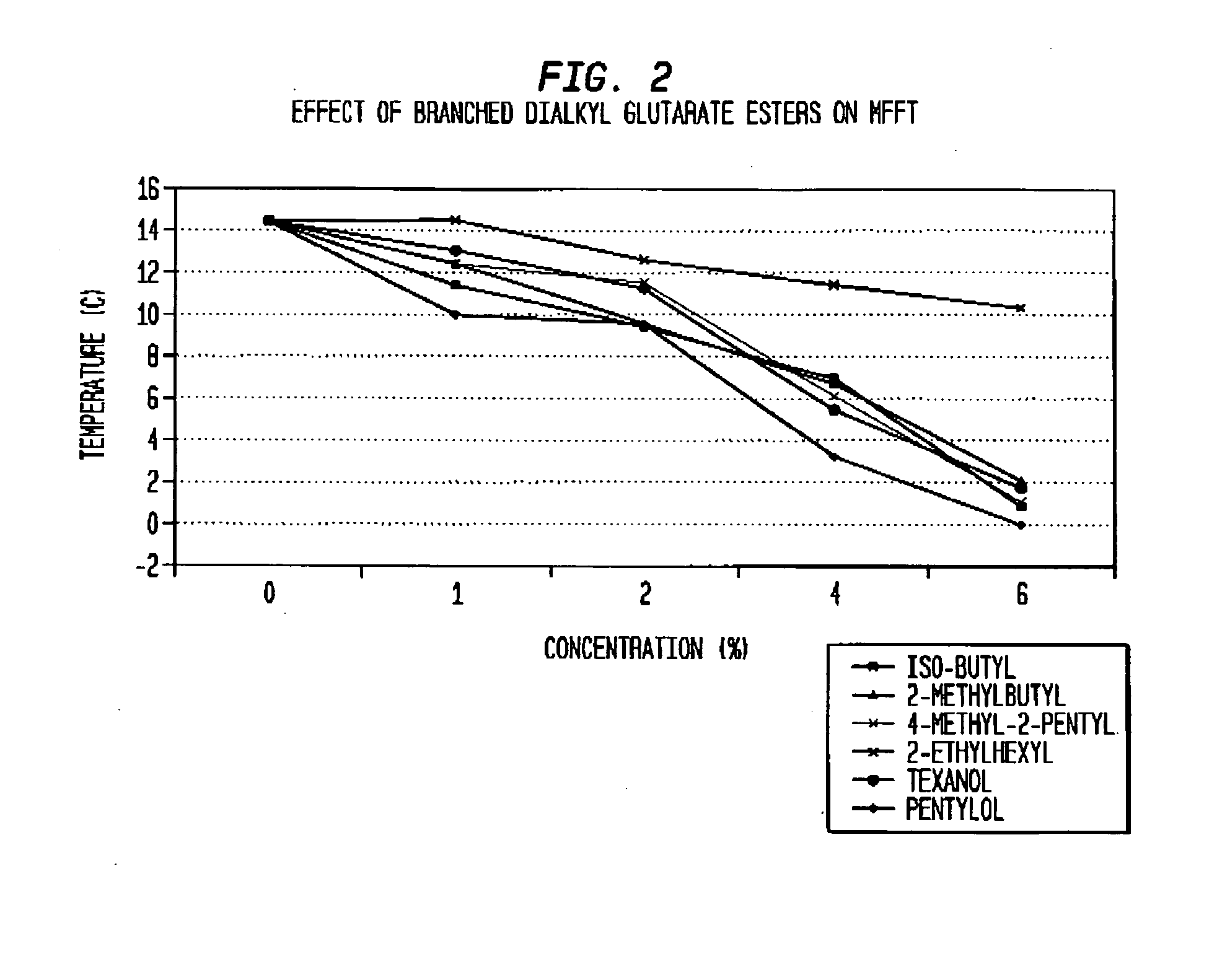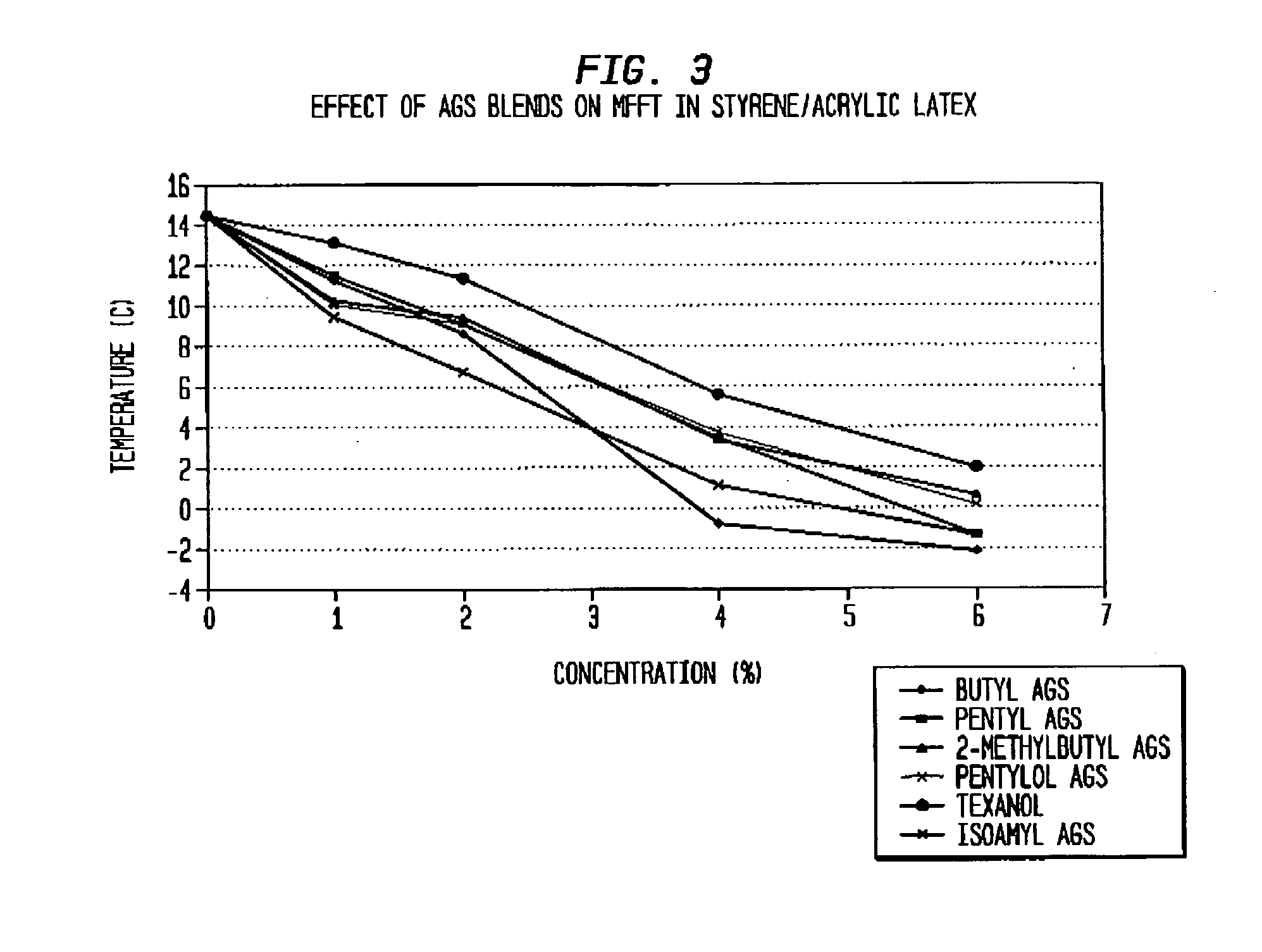Low VOC coalescing agents
a coalescing agent and low voc technology, applied in the field of coalescing agents, to achieve the effect of low water solubility, low evaporation rate, and efficient reduction of the tg of the system
- Summary
- Abstract
- Description
- Claims
- Application Information
AI Technical Summary
Benefits of technology
Problems solved by technology
Method used
Image
Examples
example 1
[0084]One primary characteristic of a coalescing agent is the efficiency in which it enables a consistent film to form, and this was determined by measuring the MFFT on a MFFT Bar 90. A coalescing agent having a minimum 50% reduction of VOC as analyzed via EPA Method 24 was desired to be developed. Finally, regardless of the product's efficiency or VOC, it was desirable that any additive formulated into a coating have minimal / no effect on the appearance of the film, as determined semi-quantitatively by drawing a film on glass and visually inspecting the surface for defects.
[0085]Experiment 1.1—Linear Diesters Using Glutaric Acid
[0086]A total of 10 diesters using glutaric acid were synthesized. To gain an understanding of structure vs. function, five linear and five branched alcohols were chosen. The five linear esters were n-dibutyl glutarate, n-dipentyl glutarate, n-dihexyl glutarate, n-diheptyl glutarate, and n-dioctyl glutarate and each was then mixed for one hour in Rhodopas DS-...
example 2
[0101]Experiments were conducted on a mixture of esters of adipic acid, methylglutaric acid and ethylsuccinic acid, sometimes referred to as “MGA”. Such experiments were conducted at varying weight percent of the coalescent agent of the present invention. As stated above, a primary characteristic of the coalescing agent of the present invention is the efficiency at which it enables a consistent film to form. This was determined by measuring the MFFT on a MFFT Bar 90. The target for the coalescing agent of the present invention is for a minimum 50% reduction of VOC as analyzed via EPA Method 24. Regardless of the product's efficiency or VOC, it is desired that any additive formulated into a coating have minimal / no effect on the appearance of the film and this was determined semi-quantitatively by drawing a film on glass and visually inspecting the surface for defects.
[0102]Referring to FIG. 6, it can be seen that the VOC content, measured via EPA Method 24, of Rhodiasolv™ DNB / M (di-n...
example 3
[0108]Experiments were carried out using the MGA and AGS esters of the present inventions as compared to a combination of the benchmark, Texanol, which is 100% VOC and a plasticizer, e.g., triethylene glycol diethylhexanoate (TEGEH), 0% VOC. (As described above, use of the plasticizer is not desirable as its use imparts poor performance characteristics such as blocking on the film.)
[0109]Because of their very high boiling point and extremely low vapor pressure, the coalescing agents of the present invention, and in particular DBM (di-butyl ester family) and DIA / M (di-iso-amyl ester family), are low VOC materials according to the USA's EPA method 24, and are VOC free based on European definition and Green Seal 11. The VOC levels of the coalescent composition by different definition, comparing to industrial standard coalescent trimethyl pentanediol monoisobutyrate ester (TMB, Texanol) and triethylene glycol diethylhexanoate (TEGEH, plasticizer), are summarized in Table 8.
TABLE 8VOC % ...
PUM
| Property | Measurement | Unit |
|---|---|---|
| Fraction | aaaaa | aaaaa |
| Fraction | aaaaa | aaaaa |
| Fraction | aaaaa | aaaaa |
Abstract
Description
Claims
Application Information
 Login to View More
Login to View More - R&D
- Intellectual Property
- Life Sciences
- Materials
- Tech Scout
- Unparalleled Data Quality
- Higher Quality Content
- 60% Fewer Hallucinations
Browse by: Latest US Patents, China's latest patents, Technical Efficacy Thesaurus, Application Domain, Technology Topic, Popular Technical Reports.
© 2025 PatSnap. All rights reserved.Legal|Privacy policy|Modern Slavery Act Transparency Statement|Sitemap|About US| Contact US: help@patsnap.com



